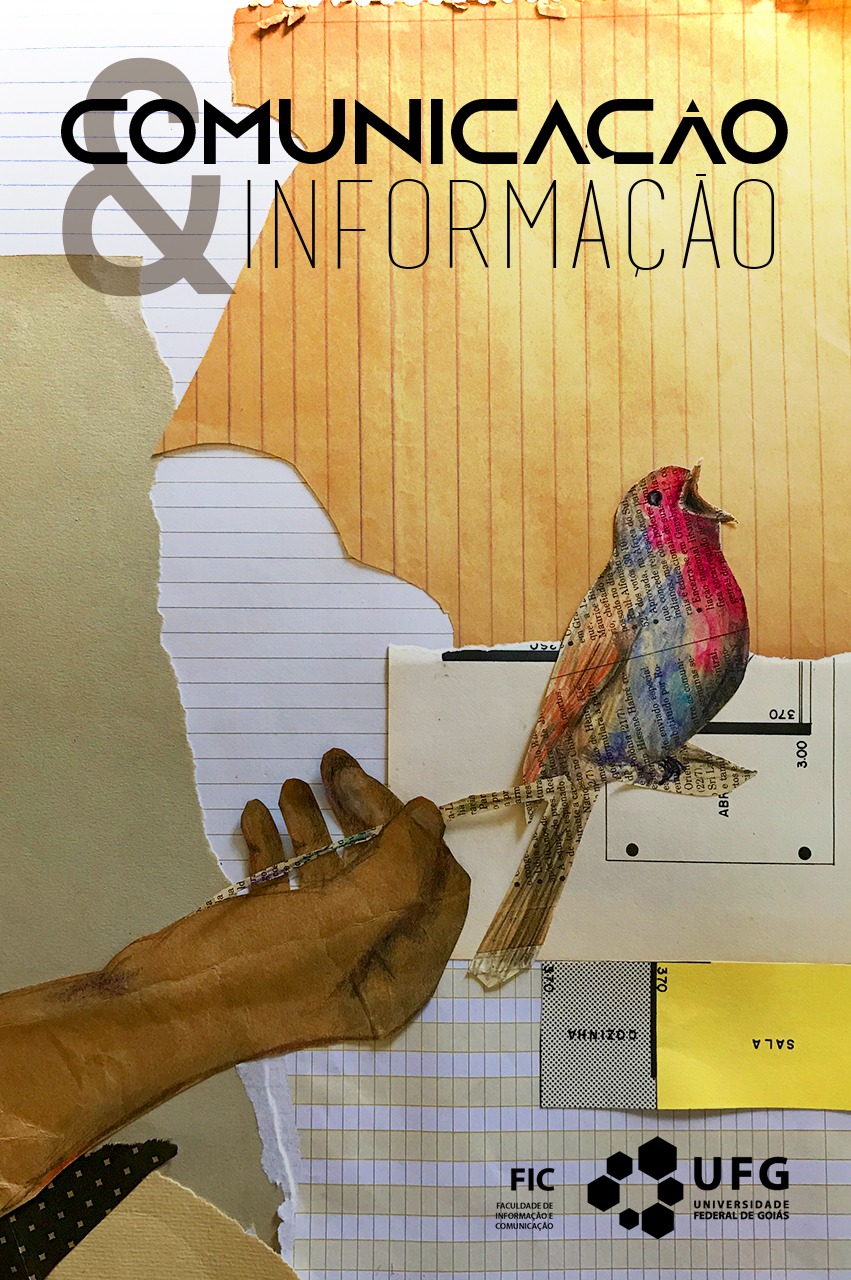analog film practice on Netflix originals
DOI:
https://doi.org/10.5216/ci.v22.66226Keywords:
Analog film, Historical film, Cinematography, Memory and cinema, NetflixAbstract
Investigate the choice of analog film practice in Netflix Originals, from the analysis of the movies “Kodachrome” (Raso, 2017), “The Meyerowitz stories” (Baumbach, 2017), “The irishman” (Scorsese, 2019), and “Da 5 bloods” (Lee, 2020). “Affective memory” and “historical memory” are two categories used to classify these pieces and study the relationship between the usage of analog film and the evocation of the past in their narratives. When choosing that specific way of shooting, these movies discuss the role of analog film amid the digital.
Downloads
References
ALBERA, François; TORTAJADA, Maria. Cinema beyond film: Media epistemology in the modern era. Amsterdam: Amsterdam University Press, 2010.
ANNETT, Sandra. The nostalgic remediation of cinema in Hugo and Paprika. Journal of Adaptation in Film & Performance, v. 7, n. 2, p. 169-180, 2014.
A QUIET place. Direção: John Krasinski. Roteiro: Bryan Woods, Scott Beck, John Krasinski. EUA: Paramount, 2018. 1 DVD (90 min), son., color.
AUMONT, Jacques. Dicionário teórico e crítico do cinema. Campinas: Papirus, 2003
AUMONT, Jacques. Que reste-t-il du cinéma? Rivista di estetica, v. 46, p. 17-31, 2011.
BARTHOLEYNS, Gil. The instant past: nostalgia and digital retro photography. In: NIEMEYER, K. Media and nostalgia: yearning for the past, present and future. New York: Palgrave Macmillan, 2014. p. 51-69
BELTRAME, Alberto; FIDOTTA, Giuseppe; MARIANI, Andrea (ed.). At the borders of (film) history: archeology, temporalities, theories. Udine-ITA: Forum, 2015.
BOLTER, Jay David; GRUSIN, Richard. Remediation: understanding new media. Cambridge: The MIT Press, 2000.
BORDWELL, David. Pandora’s digital box: films, files and the future of movies. Madison: The Irving Way Institute Press, 2012.
CASTELLANO, Mayka; MEIMARIDIS, Melina. Produção televisiva e instrumentalização da nostalgia: o caso Netflix. Revista GEMInIS, São Carlos, v. 8, n. 1, 2017.
DA 5 BLOODS. Direção: Spike Lee. Roteiro: Danny Bilson, Paul De Meo. EUA: Netflix, 2020. 1 vídeo (156 min), son., color.
ELSAESSER, Thomas; HAGENER, Malte. Film theory: an introduction through the senses. Nova York: Routledge, 2015.
ELSAESSER, Thomas. O cinema como arqueologia das mídias. São Paulo: SESC, 2018.
JOON-HO, Bong. Why didn’t Netflix let Bong Joon-ho shoot Okja on 35mm? [Entrevista concedida a] Sonia Kil. Variety. 16 maio 2017. Disponível em: variety.com/2017/film/news/bong-joon-ho-working-with-netflix-controversy-okja-cannes-1202428394/. Acesso em: 29 set. 2020.
KODACHROME. Direção: Mark Raso. Roteirista: Jonathan Tropper. EUA: Netflix, 2017, online (100 min), son., color.
LAZZARO Felice. Direção: Alice Rohrwacher. Produção: Alexandra Henochsberg, Arthur Hallereau, Grégory Gajos, Pierre-François Piet. Roteiro: Alice Rohrwacher. [S. l.]: Netflix, 2018.
LOERTSCHER, Miriam et al. As film goes byte: the change from analog to film perception. Psychology of Aesthetics Creativity and the Arts, v.10, n. 4, nov. 2016.
LOTZ, Amanda. Portals: a treatise on internet-distributed television. [S. l.]: University of Michigan Library, 2017. Disponível: http://www.amandalotz.com/portals-a-treatise-on-internetdistributed-television. Acesso: 31 jan. 2019.
MANBIKI kazoku. Direção: Hirokazu Kore-eda. Roteiro: Hirozaku Kore-eda. Japão: Gaga Corporation, 2018.1 DVD (121 min), son., color.
MANOVICH, Lev. The language of new media. Cambridge: MIT Press, 2001.
MANOVICH, Lev. The paradoxes of digital photography. Photography After Photography:Germany, p. 57–65, 1995.
MARINO, Paula Rodríguez. Memória e cinema: aproximações e problemas. Comunicação & Informação, v. 10, n. 2, 2010.
MARRIAGE story. Direção e produção: Noah Baumbach. Roteiro: Noah Baumbach. Interpretes: Scarlett Johansson, Adam Driver, Laura Dern, Alan Alda, Ray Liotta, Julie Hagerty, Merritt Wever. Veneza: Netflix, 2019. 136 min.
MMA. MOTION PICTURE ASSOCIATION OF AMERICA. Theme report. Washington, 2019. 59 p. Disponível em: https://www.motionpictures.org/research-docs/2019-theme-report/. Acesso em 6 out. 2020.
NIEMEYER, Katharina. Media and nostalgia: yearning for the past, present and future. New York: Palgrave Macmillan, 2014.
PARIKKA, Jussi. What is media archeology? Cambridge: Polity Press, 2012.
PENNINGTON, Adrian. How did Damien Chazelle convince Netflix to let him shoot 16mm? No Film School, 27 abr. 2020. Disponível em: https://nofilmschool.com/damien-chazelle-convince-netflix-16mm#:~:text=%E2%80%9CThe%20idea%20to%20shoot%2016mm,but%20I%20wanted%20this%20too.&text=He%20reveals%20that%20a%20key,by%20the%20French%20New%20Wave. Acesso em: 1 out. 2020.
RAMOS, Fernão Pessoa. Mas, afinal, o que sobrou do cinema? A querela dos dispositivos e o eterno retorno do fim. In: SOBRINHO, Gilberto Alexandre (org.). Cinemas em redes: tecnologia, estética e política na era digital. Campinas, SP: Papirus, 2016.
REYNOLDS, Simon. Retromania: pop culture’s addiction to its own past. London: Faber and Faber, 2011.
RODRIGO Prieto ASC, AMC on shooting “ The Irishman”. Arri Rental, [S. l.], c2020. Disponível em: https://www.arrirental.com/en/about/overview/news/rodrigo-prieto-asc-amc-on-shooting-the-irishman-. Acesso em: 2 out. 2020.
ROMA. Direção: Afonso Cuarón. Roteiro: Afonso Cuarón. EUA: MEX : Netflix, 2018. 1 vídeo (135 min), son., color.
SAPIO, Giuseppina. Homesick for aged home movies: why do we shoot contemporary family videos in old-fashioned ways? In: NIEMEYER, K. Media and nostalgia: yearning for the past, present and future. New York: Palgrave Macmillan, 2014. p. 39-50.
SERESIN, Bem. Reforma do monstro. Kodak, Brasil, 27 jul. 2017. Disponível em: https://www.kodak.com/BR/pt/motion/blog/blog_post/?contentid=4295002887#. Acesso em: 1 out. 2020.
SIGEL, Newton Thomas. DP Newton Thomas Sigel ASC used kodak ektachrome 16mm Film to time-travel in Spike Lee’s 'Da 5 Bloods'. Kodak Motion Picture, [S. l.], 18 jun. 2020. Disponível em: https://www.kodak.com/en/motion/blog-post/spike-lee-da-5-bloods. Acesso em: 2 out. 2020.
SILVA, Marcel Vieira Barreto, LOPES, Larissa Nascimento. Nostalgic gestures on Brazilian television series: the case of Samantha!. Comunicación y Medios, n.41, p. 106-116, 2020. DOI:10.5354/0719-1529.2020.56677
THE CLOVERFIELD paradox. Direção: Julius Onah. Roteiro: Oren Uziel. EUA: Netflix, 2018. 1 vídeo (102 min), son., color.
THE IRISHMAN. Direção: Martin Scorsese. Roteiro: Steve Zaillian. EUA: Netflix, 2019, 1 vídeo (209 min), son., color.
THE MEYEROWITZ stories: new and selected. Direção: Noah Baumbach. Roteiro: Noah Baumbach. EUA: Netflix, 2017. 1 vídeo (112 min), son., color.
JAMES, Daron.Why DP Roman Vasyanov chose anamorphic & more tales from shooting 'Suicide Squad. No Film School, [S. l.], 19 ago. 2016. Disponível em: https://nofilmschool.com/2016/08/cinematographer-roman-vasyanov-shoots-anamorphic-suicide-squad. Acesso em: 1 out. 2020.
WHY does Netflix require 4K on Netflix Originals? Netflix Partner Help Center. Disponível em: partnerhelp.netflixstudios.com/hc/en-us/articles/229150387-Why-does-Netflix-require-4K-on-Netflix-Originals-. Acesso em: 6 out. 2020.
WONDER woman. Direção: Patty Jenkins. Roteiro: Allan Heinberg. EUA: Warner Bros. 2017. 1 DVD (141 min), son., color.
Downloads
Published
How to Cite
Issue
Section
License
Os autores dos trabalhos publicados na revista Comunicação e Informação retêm os direitos autorais sem restrições e concedem à revista o direito de primeira publicação, com o trabalho simultâneo licenciado sob a Licença Creative Commons Atribuição-NãoComercial que permite o compartilhamento do trabalho para fins não comerciais com reconhecimento da autoria e o privilégio de publicação primeiramente por esta revista. Caso o texto venha a ser publicado posteriormente em outro veículo, solicita-se aos autores informar que o mesmo foi originalmente publicado como artigo na revista Perspectiva, bem como citar as referências bibliográficas completas dessa publicação.
Os direitos autorais dos artigos pertencem aos autores e o conteúdo dos artigos assinados é de responsabilidade exclusiva dos autores.
A revista se reserva o direito de efetuar, nos originais, alterações de ordem normativa, ortográfica e gramatical, com o intuito de manter o padrão culto da língua, respeitando, porém, o estilo dos autores.
A revista também se reserva o direito de traduzir o artigo, no todo ou em parte, para o inglês ou para o português, dependendo do idioma em que o artigo tenha sido escrito originalmente.



